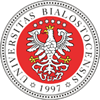Proszę używać tego identyfikatora do cytowań lub wstaw link do tej pozycji:
http://hdl.handle.net/11320/17681Pełny rekord metadanych
| Pole DC | Wartość | Język |
|---|---|---|
| dc.contributor.author | Bartoszewicz, Marek | - |
| dc.contributor.author | Czyżewska, Urszula | - |
| dc.contributor.author | Molendowska, Sandra Natalia | - |
| dc.contributor.author | Winiewicz, Anna | - |
| dc.date.accessioned | 2024-12-02T12:50:18Z | - |
| dc.date.available | 2024-12-02T12:50:18Z | - |
| dc.date.issued | 2021 | - |
| dc.identifier.citation | Modern problems and solutions in environmental protection - 2021. Post-conference monograph, edited by Urszula Czyżewska, Marek Bartoszewicz, Róża Sawczuk, Białystok 2021, s. 72-86 | pl |
| dc.identifier.isbn | 978-83-7431-692-7 | - |
| dc.identifier.uri | http://hdl.handle.net/11320/17681 | - |
| dc.description.abstract | The phenomenon of bacterial opportunism has been known for two centuries. It means the occurrence of species that generally remain completely harmless, but in conditions unfavorable for the host may lead to the development of disease symptoms. Until now, opportunistic pathogens have often been marginalized and the number of infections caused by them has been underestimated. In recent years, however, the importance of opportunistic human pathogens in the general pool of bacterial and fungal infections has been increasingly emphasized. Unfortunately, as the frequency of infections increases, so does the percentage of resistant strains among these bacteria and fungi. This is a serious therapeutic challenge, but also clearly demonstrates the need to take measures to prevent the emergence of antibiotic resistance among opportunists. These species, apart from causing infection, may constitute a natural reservoir of resistance for other, often more virulent, microorganisms and contribute to a marked reduction in the effectiveness of treatment with antibiotics and antimycotics. | pl |
| dc.language.iso | en | pl |
| dc.publisher | University of Bialystok Press | pl |
| dc.subject | facultative bacteria | pl |
| dc.subject | horizontal gene transfer | pl |
| dc.subject | side effects | pl |
| dc.subject | Bacillus cereus sensu lato | pl |
| dc.title | It's getting worse: antibiotic resistance among opportunistic pathogens | pl |
| dc.type | Book chapter | pl |
| dc.rights.holder | © Copyright by Uniwersytet w Białymstoku, Białystok 2021 | pl |
| dc.description.Affiliation | M. Bartoszewicz - Department of Microbiology and Biotechnology, Faculty of Biology, University of Bialystok, Ciolkowskiego 1J, 15-265 Białystok, Poland | pl |
| dc.description.Affiliation | U. Czyżewska - Department of Microbiology and Biotechnology, Faculty of Biology, University of Bialystok, Ciolkowskiego 1J, 15-265 Białystok, Poland | pl |
| dc.description.Affiliation | S.N. Molendowska - Department of Microbiology and Biotechnology, Faculty of Biology, University of Bialystok, Ciolkowskiego 1J, 15-265 Białystok, Poland | pl |
| dc.description.Affiliation | A. Winiewicz - Department of Microbiology and Biotechnology, Faculty of Biology, University of Bialystok, Ciolkowskiego 1J, 1 5-265 Białystok, Poland | pl |
| dc.description.references | Bartoszewicz M., Czyżewska U. (2017) Taksonomia, wirulencja i cykle życiowe Bacillus cereus sensu lato. Postępy Mikrobiologii 56: 440-450. | pl |
| dc.description.references | Bartoszewicz M., Czyżewska U. (2021) Comparison of the antibiotic resistance between genetically and toxigenic Bacillus cereus sensu lato from milk, pepper and natural habitats. Journal of Applied Microbiology 130: 370-381. | pl |
| dc.description.references | Bartoszewicz M., Czyżewska U., Siemieniuk M. (2019) It's complicated: difficult relationships between microbial ecology and taxonomy. [in:] Karpińska J., Bartoszewicz M., Sawczuk R. (Eds.). Modern problems and solutions in environmental protection. University of Bialystok Ed. House, Bialystok, pp. 126-134. | pl |
| dc.description.references | Becker B., Cooper M.A (2013) Aminoglycoside antibiotics in the 21ˢᵗ century. ACS Chemical Biology 18: 105-115. | pl |
| dc.description.references | Bush K., Bradford P.A (2016) β-lactams and β-lactamase inhibitors: an overview. Cold Spring Harbor Prospectives in Medicine. 6(8): a025247. | pl |
| dc.description.references | Coleman D.C., Chopra I., Shales S.W., Howe T.G., Foster T.G. (1982) Analysis of tetracycline resistance encoded by transposon Tn10: deletion mapping of tetracycline-sensitive point mutations and identification of two structural genes. Journal of Bacteriology 153: 921-929. | pl |
| dc.description.references | Czyżewska U., Siemieniuk M., Bartoszewicz M., Tylicki A. (2018) Grzyby z rodzaju Malassezia jako oportunisci ludzi i zwierząt. Postępy Higieny i Medycyny Doswiadczalnej 72: 359-375. | pl |
| dc.description.references | Davies J., Davies D. (2010) Origins and evolution of antibiotic resistance. Microbiology and Molecular Biology Reviews 73: 417-433. | pl |
| dc.description.references | Forrester J.V., McMenamin P.G., Dando S.J. (2018) CNS infection and immune privilege. Nature Reviews Neuroscience 19: 655-671. | pl |
| dc.description.references | Fyfe C., Grossman F.C., Kerstein K., Sutcliffe J. (2016) Resistance to macrolide antibiotics in public health pathogens. Cold Spring Harbor Prospectives in Medicine 6(10):a025395. | pl |
| dc.description.references | Hobson C., Chan A.N., Wright G.D. (2021) The Antibiotic Resistome: A Guide for the Discovery of Natural Products as Antimicrobial Agents. Chemical Reviews, 121: 3464-3494. | pl |
| dc.description.references | Iredell I., Brown J., Tagg K. (2016) Antibiotic resistance in Enterobacteriaceae: mechanisms and clinical implications. BMJ 8: 352h6420. | pl |
| dc.description.references | Jagielski T., Rup E., Macura A.B., Bielecki J. (2013) Charakterystyka grzybów z rodzaju Malassesia. Aspekty mikrobiologiczne i immunologiczne. Postępy Mikrobiologii 53: 295-305. | pl |
| dc.description.references | Khan A.U., Maryam L., Zarrilli R. (2017) Structure, genetic and worldwide spread of New Delhi metallo-beta-lactamase (NDM): a threat to public health. BMC Mirobiology 17: 101. | pl |
| dc.description.references | Kozinska A., Sitkiewicz I. (2017) „Nowe" i „stare" antybiotyki - mechanizmy dzialania i strategie poszukiwania leków przeciwbakteryjnych. Kosmos. Problemy nauk biologicznych 66: 109-124. | pl |
| dc.description.references | Li C-H., Cheng Y.-W., Liao P.-L., Yang Y.-T., Kang J.-J. (2010) Chloramphenicol causes mitochondrial stress, decreases ATP biosynthesis, induces matrix metallopreteinase-13 expression, and solid-tumor cell invasion. Toxicological sciences 116: 140-150. | pl |
| dc.description.references | Malinowska M., Tokarz-Deptuła B., Deptuła W. (2018) Mikrobiom czlowieka. Postępy Mikrobiologii 56: 33-42. | pl |
| dc.description.references | Marosevic D., Kaevska M., Jaglic Z. (2017) Resistance to the tetracyclines and macrolide-lincosamiide-streptogramin group of antibiotics and its genetic linkage - a review. Annales of Agricultural and Environmental Medicine 24: 338-344. | pl |
| dc.description.references | Mehlich A., Górska S., Gamian A., Myc A (2015) Wybrane aspekty zakażen Clostridium dififcile. Postępy Higieny i Medycyny Doświadczalnej 69: 598-611. | pl |
| dc.description.references | Milles L.F., Schulten K., Gaub H.E., Bernardi F.C. (2018) Molecular mechanism of extreme mechanostability in a pathogen adhesin. Science 359: 1527-1533. | pl |
| dc.description.references | Nowicka J., Bartoszewicz M., Rygiel A. (2012) Czynniki wirulencji i chorobotwórczość gronkowców koagulazo-ujemnych. Forum zakażen, 3(2): 83-89. | pl |
| dc.description.references | Podgórska B., Kędzia D. (2018a) From a commensal to a pathogen - two faces of Staphylococcus epidermidis. Postępy Mikrobiologii 57: 338-348. | pl |
| dc.description.references | Podgórska B., Kędzia D. (2018b) Staphylococcus epidermidis as a causative agent of healthcare-associated infections. Postępy Mikrobiologii 57: 348-359. | pl |
| dc.description.references | Poreau B. (2014) The history of commensalism: a contemporary history of microbiology. Histoire des sciences medicinales 48: 61-68. | pl |
| dc.description.references | Potrykus J., Węgrzyn G. (2001) Chloramphenicol-sensitive Escherichia coli strain expressing the chloramphenicol acetyltransferase (cat) gene. Antimicrobial Agents and Chemiotherapy 45: 3610-3612. | pl |
| dc.description.references | Szemraj M., Czekaj T., Kalisz J., Szewczyk E.M. (2019) Differences in distribution of MLS antibiotic resistance genes in clinical isolates of staphylococci belonging to species: S. epidermidmis, S. hominis, S. haemolyticus, S. simulans and S. warneri. BMC Microbiology 19:124. | pl |
| dc.description.references | Tooke C.L., Hinchliffe P., Bragginton E.C., Colenso C.K., Hirvonen V.H.A, Takebayashi Y., Spencer J. (2019) j3-Lactamases and β-Lactamase Inhibitors in the 21st Century. Journal of Molecular Biology 431: 3472-3500. | pl |
| dc.description.references | Wolstenholme A.J., Kaplan R.M. (2012) Resistance to macrocyclic lactones. Current Pharmacology and Biotechnology 13: 873-87. | pl |
| dc.description.references | Yunis A.A. (1988) Chloramphenicol: relation of structure to activity and toxicity. Annual Review of Pharmacology and Toxicology 28: 83-100. | pl |
| dc.description.references | Zaffiri L., Gardner J., Toledo-Pereyra L.H. (2012) History of antibiotics: from salvarsan to cephalosporins. Journal of Investigative Surgery 25: 67-77. | pl |
| dc.description.firstpage | 72 | pl |
| dc.description.lastpage | 86 | pl |
| dc.identifier.citation2 | Modern problems and solutions in environmental protection - 2021. Post-conference monograph, edited by Urszula Czyżewska, Marek Bartoszewicz, Róża Sawczuk | pl |
| dc.conference | XVI Międzynarodowa Interdyscyplinarna Konferencja „Current Environmental Issues – 2021”, Białystok 22-24 września 2021 r. | pl |
| Występuje w kolekcji(ach): | Książki / Rozdziały (WUwB) Materiały konferencyjne (WBiol) XVI Międzynarodowa Interdyscyplinarna Konferencja „Current Environmental Issues-2021”, 22-24 września 2021 | |
Pliki w tej pozycji:
| Plik | Opis | Rozmiar | Format | |
|---|---|---|---|---|
| M_Bartoszewicz_et_al_Its_getting_worse.pdf | 1,19 MB | Adobe PDF | Otwórz |
Pozycja jest chroniona prawem autorskim (Copyright © Wszelkie prawa zastrzeżone)

